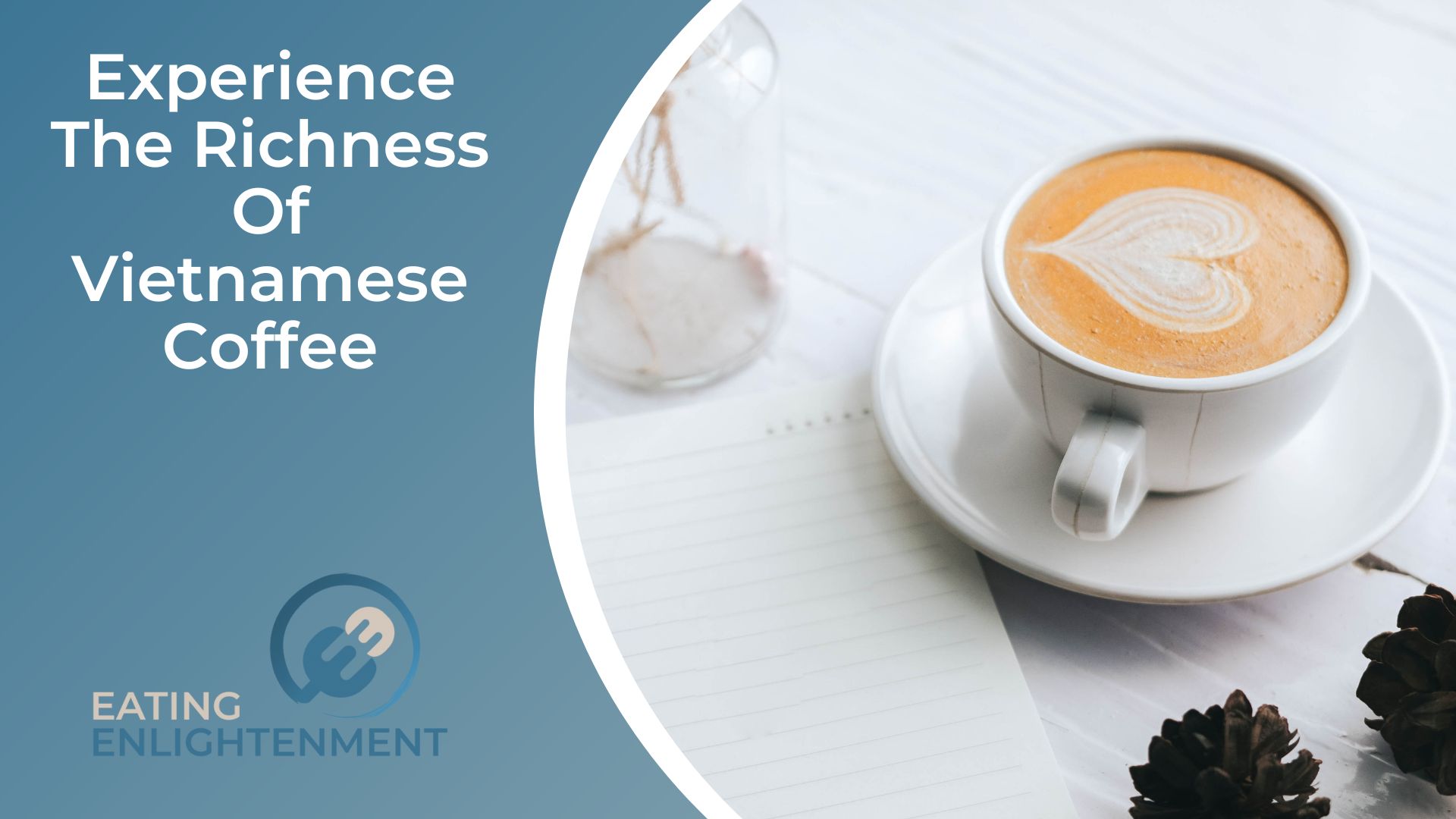Vietnamese coffee is a unique and flavorful experience that has captivated the hearts of many coffee enthusiasts. With its strong and robust taste, it’s no wonder why Vietnamese coffee has become a popular choice for those seeking an energizing morning pick-me-up or a relaxing afternoon indulgence.
This article aims to provide readers with an in-depth understanding of Vietnamese coffee, including its history, brewing methods, flavor profile, and pairing suggestions. Whether you’re a seasoned coffee aficionado or just starting your journey into the world of specialty coffees, this guide will help you explore the richness and complexity of Vietnamese coffee. So sit back, grab a cup of joe, and let’s dive into the world of Vietnamese coffee!
The History of Vietnamese Coffee
This section delves into the historical background of the beverage that has become an integral part of Vietnam’s cultural identity, highlighting its evolution and significance over time. Vietnamese coffee is a product of various cultural influences on Vietnam throughout its history. Coffee was first introduced to Vietnam in the late 19th century by French colonizers who sought to establish plantations in the country. The French brought with them Arabica coffee beans from Africa and South America, which were grown primarily in the highlands.
Vietnamese coffee culture evolved during the colonial period as locals began to acquire knowledge about coffee cultivation and processing techniques from their French colonizers. The cultural significance of Vietnamese coffee can be observed through its consumption rituals, including unique brewing methods and serving styles that have been passed down through generations. Today, Vietnamese coffee remains a symbol of national pride for many Vietnamese people and is enjoyed not only for its taste but also for its rich cultural heritage.
Brewing Methods for the Perfect Cup
The process of brewing coffee plays a significant role in the flavor and aroma of the final product, and understanding various methods can lead to the perfect cup. Vietnamese coffee is no exception, as brewing techniques have evolved over time to create unique blends that showcase its rich flavor profile. Two popular methods for brewing Vietnamese coffee are the French press and pour-over.
The French press method involves steeping coarsely ground beans in hot water before pressing them through a mesh filter to separate the liquid from the grounds. This technique allows for greater extraction of oils and flavors from the beans, resulting in a full-bodied brew with a robust taste. In contrast, pour-over uses finely ground beans placed in a paper or metal filter that sits on top of a single-serving cup or carafe. Hot water is then poured over the grounds, slowly releasing their flavors into the liquid below. This method produces a clean-tasting coffee with bright acidity and subtle nuances of flavor. Other popular methods for brewing Vietnamese coffee include cold brew and espresso shots, each offering their own distinct taste experience.
Flavor Profile and Taste Notes

Understanding the flavor profile and taste notes of brewed coffee is crucial in determining which method to use, as different brewing techniques can accentuate certain flavors and aromas. Vietnamese coffee culture is known for its unique blend of robusta and arabica beans, roasted with butter or oil to create a distinct flavor profile. The resulting brew is often described as bold, rich, and slightly sweet with hints of chocolate and nutty undertones.
Regional variations also play a significant role in the taste notes of Vietnamese coffee. For example, beans grown in the Central Highlands region tend to have a more earthy flavor profile due to the volcanic soil they are grown in. In contrast, beans from the northern regions have a milder taste with floral notes due to their cooler climate. Understanding these regional differences can help coffee enthusiasts appreciate the nuances of Vietnamese coffee and choose brewing methods that best highlight its unique characteristics.
Pairing Vietnamese Coffee with Food and Desserts
Pairing coffee with food and desserts is an essential aspect of the culinary arts, as it involves exploring the complementary flavors and textures that can elevate both the beverage and dish. In Vietnamese coffee culture, pairing coffee with sweet treats is a common practice. The bold flavor profile of Vietnamese coffee blends well with various desserts, such as flan, cheesecake, or ice cream. The strong taste of Vietnamese coffee also complements savory dishes like pho or banh mi.
Fusion cuisine has become increasingly popular in recent years, blending different cultural cuisines to create unique dishes. Pairing Vietnamese coffee with fusion dishes can offer an exciting dining experience for those who love experimenting with new tastes. For instance, pairing a cup of strong iced Vietnamese coffee with Korean bibimbap or Thai green curry can create a balance between the bitterness of the beverage and spiciness of the dish. Overall, experimenting with pairing Vietnamese coffee in different ways can enhance one’s culinary journey while experiencing the richness of this flavorful drink.
Frequently Asked Questions
What is the caffeine content of Vietnamese coffee compared to other types of coffee?
Vietnamese coffee is known for its strong and bold flavor, but how does its caffeine content compare to other types of coffee? When comparing the caffeine content of Vietnamese coffee to other brewing methods, it falls in the middle range. For example, a 8 oz. cup of brewed Vietnamese coffee typically contains around 80-100 milligrams of caffeine, while an 8 oz. cup of drip-brewed coffee can contain anywhere from 95-200 milligrams of caffeine depending on the roast and type of bean used. Additionally, espresso-based drinks such as cappuccinos or lattes generally contain less caffeine than a regular cup of coffee due to their smaller volume. It’s important to note that factors such as grind size and brew time can also affect the amount of caffeine in your cup. Overall, while Vietnamese coffee may not be the strongest in terms of caffeine content compared to other brewing methods, it still offers a rich and satisfying experience for those who enjoy its unique flavor profile.
What are the environmental impacts of Vietnamese coffee production?
Vietnamese coffee production has significant environmental impacts, including deforestation and the use of chemical fertilizers. However, there are sustainability practices being implemented by some producers to mitigate these negative effects. For example, some farmers are using organic farming techniques, such as composting and intercropping, to reduce the need for chemical inputs and promote soil health. Additionally, fair trade certification is becoming more common in the Vietnamese coffee industry, ensuring that growers receive fair prices for their products and promoting environmentally sustainable practices. While there is still much work to be done to make Vietnamese coffee production more sustainable, these efforts represent important steps towards a more responsible industry.
How has the popularity of Vietnamese coffee changed over time?
The popularity of Vietnamese coffee has grown significantly over time, with its impact on the local economy being a key factor in this growth. The increase in demand for Vietnamese coffee has been driven by several factors, including the influence of international coffee culture and the unique taste and quality of Vietnamese coffee. As a result, Vietnam has become one of the largest exporters of coffee in the world. This growth has had positive effects on the local economy, creating job opportunities and contributing to economic development. Additionally, it has also provided an opportunity for Vietnamese farmers to improve their livelihoods through increased income from coffee production. Despite these benefits, there are concerns about the environmental impacts associated with intensive coffee cultivation practices that should be addressed to ensure sustainable production in the future.
Are there any cultural traditions associated with drinking Vietnamese coffee?
Vietnamese coffee is not just a beverage, but also a cultural phenomenon. The country’s coffee etiquette and ceremonies reflect the importance of socializing and respect for others. Coffee shops are places where people gather to discuss business, politics or simply catch up with friends while sharing a cup of strong and flavorful Vietnamese coffee. The traditional way to prepare this drink involves using a phin filter, which is placed over the cup, filled with ground coffee beans and hot water that slowly drips through it into the cup. This ritualistic process highlights the patience and care required to make good coffee while allowing time for conversation. Additionally, Vietnamese weddings often include a coffee ceremony where the bride and groom offer each other cups of coffee as a symbol of their union. These cultural traditions show how deeply entrenched Vietnamese coffee is in everyday life and emphasize its significance as more than just a caffeine boost.
Can Vietnamese coffee be made without a traditional phin filter?
Alternative methods for making Vietnamese coffee do exist, though they may yield a different taste profile compared to the traditional phin filter. One such method is using a French press, which requires coarser grounds and a longer steeping time. Another alternative is using a drip cone or pour-over method, which also requires coarser grounds and hot water poured over slowly. While these methods may produce a smoother and less intense flavor than the phin filter, they still allow for the unique combination of robusta beans and sweetened condensed milk that characterizes Vietnamese coffee. Ultimately, taste comparison is subjective and dependent on personal preference, but experimenting with different methods can offer new perspectives on this beloved cultural beverage.
Conclusion
Vietnamese coffee is a delicious and unique experience that anyone can enjoy. Its rich history and unique brewing methods make it a favorite among coffee lovers around the world. The robust flavor profile of Vietnamese coffee, with its notes of chocolate, caramel, and spice, make it an excellent pairing for many different types of food.
One anecdote that illustrates the richness of Vietnamese coffee is the story of how it was first introduced to American soldiers during the Vietnam War. Soldiers had grown accustomed to drinking weak instant coffee and were amazed by the strong flavor and aroma of Vietnamese coffee served in local cafes. This introduction sparked a love affair with Vietnamese coffee that continues to this day.
Data shows that Vietnam is now one of the largest exporters of coffee in the world, with over 20% of global production coming from this country alone. The popularity of Vietnamese-style coffee shops has also been on the rise in recent years, with many people seeking out these establishments for their authentic atmosphere and unique blends.
In conclusion, experiencing Vietnamese coffee is a must for any true lover of this beloved beverage. From its rich history to its unique brewing methods and bold flavor profile, there are many reasons why this style of coffee has become so popular around the world. So whether you’re sipping on a cup at your favorite cafe or enjoying it alongside a delicious meal or dessert, take some time to savor all that Vietnamese coffee has to offer – you won’t be disappointed!



